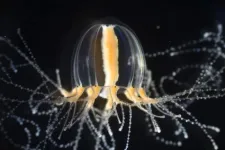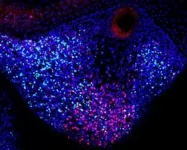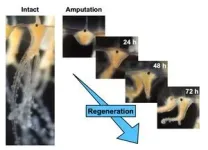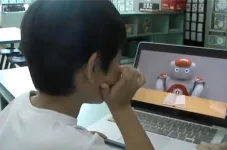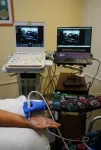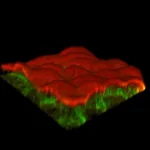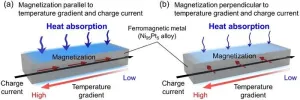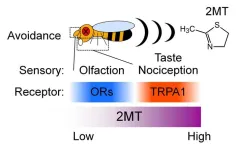(Press-News.org) At about the size of a pinkie nail, the jellyfish species Cladonema can regenerate an amputated tentacle in two to three days — but how? Regenerating functional tissue across species, including salamanders and insects, relies on the ability to form a blastema, a clump of undifferentiated cells that can repair damage and grow into the missing appendage. Jellyfish, along with other cnidarians such as corals and sea anemones, exhibit high regeneration abilities, but how they form the critical blastema has remained a mystery until now.
A research team based in Japan has revealed that stem-like proliferative cells — which are actively growing and dividing but not yet differentiating into specific cell types — appear at the site of injury and help form the blastema.
The findings were published in the scientific journal PLOS Biology.
“Importantly, these stem-like proliferative cells in blastema are different from the resident stem cells localized in the tentacle,” said corresponding author Yuichiro Nakajima, lecturer in the Graduate School of Pharmaceutical Sciences at the University of Tokyo. “Repair-specific proliferative cells mainly contribute to the epithelium — the thin outer layer — of the newly formed tentacle.”
The resident stem cells that exist in and near the tentacle are responsible for generating all cellular lineages during homeostasis and regeneration, meaning they maintain and repair whatever cells are needed during the jellyfish’s lifetime, according to Nakajima. Repair-specific proliferative cells only appear at the time of injury.
“Together, resident stem cells and repair-specific proliferative cells allow rapid regeneration of the functional tentacle within a few days,” Nakajima said, noting that jellyfish use their tentacles to hunt and feed.
This finding informs how researchers understand how blastema formation differs among different animal groups, according to first author Sosuke Fujita, a postdoctoral researcher in the same lab as Nakajima in the Graduate School of Pharmaceutical Sciences.
“In this study, our aim was to address the mechanism of blastema formation, using the tentacle of cnidarian jellyfish Cladonema as a regenerative model in non-bilaterians, or animals that do not form bilaterally — or left-right — during embryonic development,” Fujita said, explaining that the work may provide insight from an evolutionary perspective.
Salamanders, for example, are bilaterian animals capable of regenerating limbs. Their limbs contain stem cells restricted to specific cell-type needs, a process that appears to operate similarly to the repair-specific proliferative cells observed in the jellyfish.
“Given that repair-specific proliferative cells are analogues to the restricted stem cells in bilaterian salamander limbs, we can surmise that blastema formation by repair-specific proliferative cells is a common feature independently acquired for complex organ and appendage regeneration during animal evolution,” Fujita said.
The cellular origins of the repair-specific proliferative cells observed in the blastema remain unclear, though, and the researchers say the currently available tools to investigate the origins are too limited to elucidate the source of those cells or to identify other, different stem-like cells.
“It would be essential to introduce genetic tools that allow the tracing of specific cell lineages and the manipulation in Cladonema,” Nakajima said. “Ultimately, understanding blastema formation mechanisms in regenerative animals, including jellyfish, may help us identify cellular and molecular components that improve our own regenerative abilities.”
###
Funding:
The research is supported by grants from the Japan Society for the Promotion of Science KAKENHI, Japan Science and Technology Agency, Japan Agency for Medical Research and Development, and Japan’s National Institute for Basic Biology collaborative research program.
Related links:
Graduate School of Pharmaceutical Sciences: https://www.f.u-tokyo.ac.jp/en/
Research contacts:
Sosuke Fujita, Postdoctoral researcher
Graduate School of Pharmaceutical Sciences, The University of Tokyo
Email: sosuke.rinama@gmail.com
Yuichiro Nakajima, Lecturer
Graduate School of Pharmaceutical Sciences, The University of Tokyo
Email: nakaji97@g.ecc.u-tokyo.ac.jp
About the University of Tokyo
The University of Tokyo is Japan's leading university and one of the world's top research universities. The vast research output of some 6,000 researchers is published in the world's top journals across the arts and sciences. Our vibrant student body of around 15,000 undergraduate and 15,000 graduate students includes over 4,000 international students. Find out more at www.u-tokyo.ac.jp/en/ or follow us on Twitter at @UTokyo_News_en
END
How jellyfish regenerate functional tentacles in days
2023-12-22
ELSE PRESS RELEASES FROM THIS DATE:
Reindeer sleep while chewing their cud
2023-12-22
Researchers report December 22 in the journal Current Biology that the more time reindeer spend ruminating, the less time they spend in non-rapid eye movement (non-REM) sleep. EEG recordings revealed that reindeer’s brainwaves during rumination resemble the brain waves present during non-REM sleep, and these brainwave patterns suggest that the reindeer are more “rested” after ruminating. The researchers speculate that this multitasking might help reindeer get enough sleep during the summer months, when food is abundant ...
Trends in abdominoplasty: More outpatient surgery and concomitant liposuction
2023-12-22
Waltham — December 22, 2023 —
Abdominoplasty continues to be a safe and effective procedure, with more cases performed on an outpatient basis and increased use of concomitant liposuction, according to a new 16-year analysis in the January issue of Plastic and Reconstructive Surgery®, the official medical journal of the American Society of Plastic Surgeons (ASPS). The journal is published in the Lippincott portfolio by Wolters Kluwer.
"Taking advantage of quality-improvement data submitted by US Board-certified plastic surgeons, our study provides new insight ...
Like kids in a candy store
2023-12-22
Kyoto, Japan – A non-prescription drug abuse crisis in Japan seems only one overdose away. The demand for a particular anti-cough drug has been rising, along with the social impact of its abuse due to its psychosomatic effects.
The ease of obtaining information online about how to acquire over-the-counter medications or OTCs for achieving overdose, however, does not appear to be the real problem.
Now, a study by a team of researchers at Kyoto University suggests that reliable information about OTC abuse needs to be readily available and effectively disseminated.
"We ...
Robots versus humans: Which would children trust more when learning new information?
2023-12-22
In this digital age, children are exposed to overwhelming amounts of information online, some of it unverified and increasingly generated by non-human sources, such as AI-driven language models. As children grow older, the ability to assess a source’s reliability is an important skill in cultivating critical thinking.
Children aged three to five years display selective trust based on the informant’s past accuracy when faced with both humans and robots, according to a study published in the journal Child Development titled, ‘Younger, not older, ...
AI tool aids in screening for nerve disorder
2023-12-22
Researchers at the Indian Institute of Science (IISc), in collaboration with Aster-CMI Hospital, have developed an AI tool that can identify the median nerve in ultrasound videos and detect carpal tunnel syndrome (CTS). The study was published in IEEE Transactions on Ultrasonics, Ferroelectrics, and Frequency Control.
CTS arises when the median nerve, which runs from the forearm into the hand, is compressed at the carpal tunnel part of the wrist, resulting in numbness, tingling or pain. It ...
Big impacts from small changes in cell
2023-12-22
Tiny things matter – for instance, one amino acid can completely alter the architecture of the cell. Researchers at the Universities of Göttingen and Warwick investigated the structure and mechanics of the main component of the cytoskeleton of the cell: a protein known as actin. Actin is found in all living cells where it has a range of important functions – from muscle contraction to cell signalling and cell shape. This protein comes in two different varieties termed “isoforms”, which are known as gamma actin and beta actin. The difference between the two proteins is ...
Jupiter was targeted by exoplanet hunter
2023-12-22
For the first time, an instrument to find planets light years away was used on an object in the Solar System, in a study on Jupiter's winds.
We find ourselves at a time when it has become almost commonplace to discover planets orbiting another star, with more than 5,000 already registered. The first distant worlds to incorporate this list were mainly giant planets, similar to but also very different in many ways from Jupiter and Saturn.
Astrophysicists have already begun to obtain data on the atmospheres of exoplanets, but fundamental ...
Pandemic lessons: Insights into how mobility restrictions affect healthcare costs
2023-12-22
Osaka, Japan - As the world grappled with lockdowns and restrictions brought by the COVID-19 pandemic, researchers at Osaka Metropolitan University conducted an extensive study to elucidate the link between changes in human mobility and the impact on medical costs associated with lifestyle-related diseases.
Dr. Haruka Kato and Professor Atsushi Takizawa of the Graduate School of Human Life and Ecology at Osaka Metropolitan University were concerned by the negative health effects resulting from the restriction of ...
Controlling thermoelectric conversion in magnetic materials by magnetization direction
2023-12-22
1. NIMS has succeeded in directly observing the "anisotropic magneto-Thomson effect," a phenomenon in which the heat absorption/release proportional to an applied temperature difference and charge current (i.e., Thomson effect) changes anisotropically depending on the magnetization direction in magnetic materials. This research is expected to lead to further development of basic physics and materials science related to the fusion area of thermoelectrics and spintronics, as well as to development of new functionalities to control thermal energy with magnetism.
2. The Thomson effect has long been known as one of the fundamental ...
Stinky, bitter, and painful: A novel insect repellent attacks multiple sensory pathways
2023-12-22
Okazaki, Japan – crop damage in agriculture and the transmission of vector-borne diseases by insect pests have become worldwide threat nowadays. Chemical treatments such as insecticides and repellents have been a major strategy against insect pests for centuries. Due to limited understanding of mechanisms of insect avoidance behavior, however, development of insect repellents has been delayed. To discover compounds that effectively repel insect pests, it is important to focus on key molecules associated with sensory, particularly aversive, responses. In this study, researchers ...
